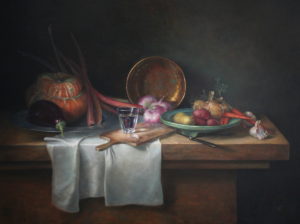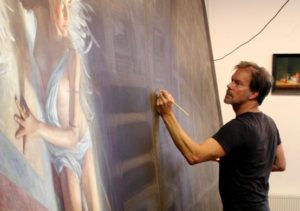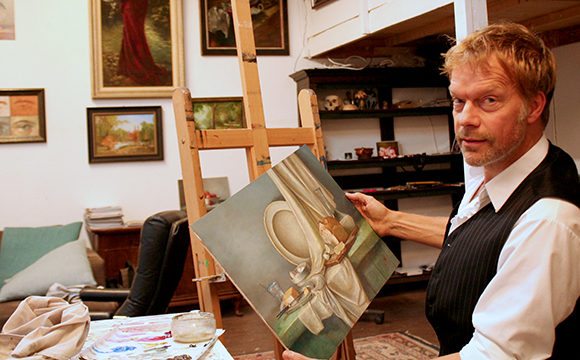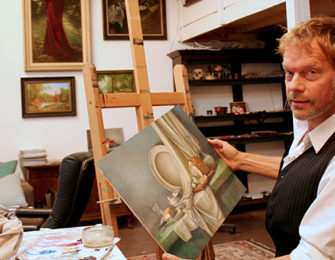Why would a modern artist want to paint like the masters from the 17th century? What makes paintings of fruit, bread, and flowers meaningful? Painter Paul van Ernich talks about time-honored techniques and the secret visual language of realist art in this Captivated by… interview.
Van Ernich will show a body of work comprised of still-lifes, portraits, and mythological subjects in a solo exhibition opening February 27, 2018 at Casa Romantica Cultural Center and Gardens. Casa Romantica interviewed van Ernich to learn more about his craft and motivations.
–
CR: What inspired you to paint with the same technique as the Dutch ‘Old Masters?’
PvE: I remember feeling a profound admiration for the ‘Old Masters’ when I visited the Rijksmuseum in Amsterdam as a teenager. The painters of these magnificent works of art were like sorcerers to me. For about a decade, I painted in an abstract expressionist style, but I could not shake wanting to get in touch with my Dutch roots: with tradition, craftsmanship. I wanted my personal convictions and style to be seen through the lens of realism; I needed to prove to myself that I could create ‘realist’ representational paintings instead of hiding technical training underneath modern art.
It was a combination of this technical challenge, my wish to better articulate my personal convictions, and a desire to preserve the heritage of my ancestors that caused me to devote my practice to realism-based Dutch-style painting. The Dutch Masters of the 17th century Baroque period were able to create depth, drama and precision by building up a composition using several thin layers of oil paint. They refined basic painting tools into a set of precision techniques which allowed a perfect translation of their subjects into paint. By painting like they did, I am a steward of the knowledge that keeps their outstanding techniques from becoming lost.
 CR: What is more meaningful to you: the act of painting and preserving ephemeral objects, or the symbolism of those objects?
CR: What is more meaningful to you: the act of painting and preserving ephemeral objects, or the symbolism of those objects?
PvE: To me, the preservation of the ephemeral is more important. There is a paradox when one creates a still-life painting: painting things that die or decay, such as food or flowers, yet stopping the process of decay by putting its likeness into an image that can be preserved for centuries. There is a Latin word that is used to describe this concept, called ‘vanitas:’ everything fades and/or vanishes. It is human vanity to want to preserve things which will, in the end, decay, but realizing one’s vulnerability on this level is the moralistic lesson in many still-life paintings.
Some commonly-painted objects in still-life works have a symbolic value as classic examples of vanitas. They are called ’emblemata’ because their appearance in a painting serves as a visual language. Some art historians claim to know the meaning of all the objects in a still-life, but there is very little said about this by the painters themselves. Painters in the Dutch ‘Golden Age’ were often more occupied with their composition; the draftsmanship of the painting, the balance of colors and values and painted layers that give each object in the painting a realistic appearance. In short: the pictorial aspects dominated the symbolic significance. I don’t care too much about these emblemata, myself. I make up my own symbolic references.
 CR: What interests you about painting mythological themes?
CR: What interests you about painting mythological themes?
PvE: In my younger years, I studied Psychology and specialized in Culture. This influence is still to be found in the themes I gravitate to. I recently became more interested in painting mythological themes because art is about storytelling, and storytelling connects people. Myths are the archetypal stories; their themes are recurrent across every culture as a way pass along wisdom or spirituality. In my largest-sized paintings to date, I have translated the Greek myth of Icarus into a story about courage. It’s a story about falling down, getting up, and trying again. It’s also a lesson about the awareness that life in itself is a divine gift.
CR: Why did you choose California as a place to teach the Old Master techniques on an annual basis?
PvE: By accident (as many major life-events happen), a friend invited me about ten years ago to join him on an overseas trip to visit his daughter, who lived in San Clemente. I am a fan of surfing, and he stressed that I should come with him as this was one of the best places to surf. I spent three weeks with my friend at his daughter’s house and offered her something in return for my stay; she asked for a mural painting of a California sunset. When I visited the local art store [San Clemente Art Supply] to buy supplies, I met the owners and we connected very well. They invited me back to teach art classes when they learned that I teach the Old Masters technique at home in The Netherlands, and now I teach in California each year as well.
CR: What interests you about exhibiting at Casa Romantica Cultural Center and Gardens?
PvE: Since my first stay in San Clemente, I fell in love with California. What I especially appreciate is the attention and focus that people here give to the techniques that I have to share. What better place could you wish than Casa Romantica to show works of art which reflect your deepest self? I’m a romantic — that’s obvious — so my paintings will thrive in this romantic setting. Furthermore, Casa Romantica is a place with a great history. Its ambiance enhances the value of my work. It’s as if the setting provides the right vocabulary with which to interpret my art.

 Blog
Blog  Casa Captivating
Casa Captivating  Captivated by… Paul van Ernich, oil painter
Captivated by… Paul van Ernich, oil painter
 Blog
Blog
 Captivated by… Paul van Ernich, oil painter
Captivated by… Paul van Ernich, oil painter


 CR: What is more meaningful to you: the act of painting and preserving ephemeral objects, or the symbolism of those objects?
CR: What is more meaningful to you: the act of painting and preserving ephemeral objects, or the symbolism of those objects? CR: What interests you about painting mythological themes?
CR: What interests you about painting mythological themes?